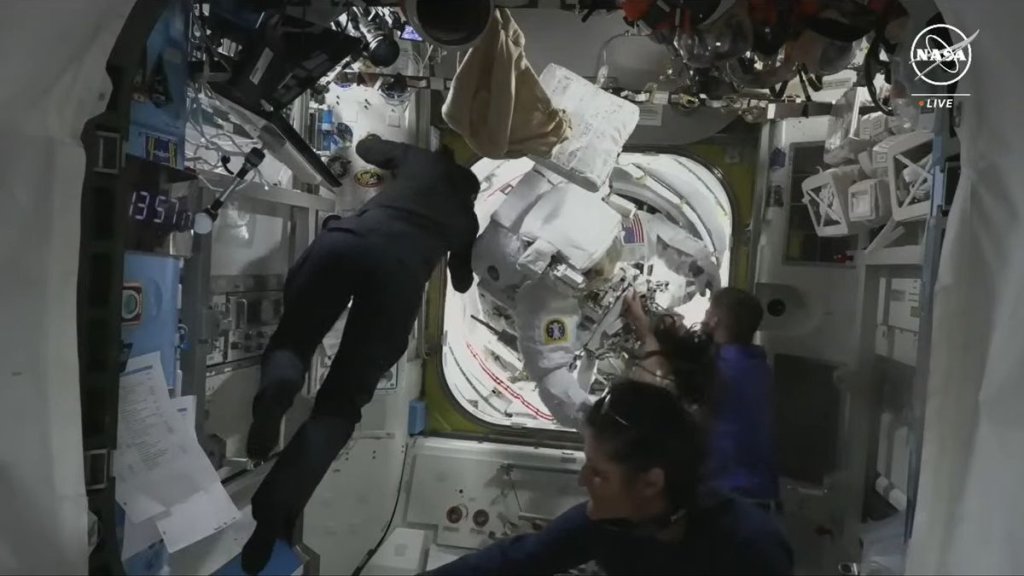Astronauts are performing a “spacewalk review” in orbit after a coolant leak cancelled a planned excursion on Monday (June 24), NASA officials said in an update.
NASA astronauts Tracy Caldwell Dyson and Mike Barratt halted the spacewalk while still in the International Space Station (ISS) hatch, due to a spacesuit coolant leak in Dyson’s spacesuit. Today (June 25), NASA said the crew is reviewing what to do next, in consultation with Mission Control. “Barratt began Tuesday morning troubleshooting Dyson’s spacesuit and inspecting the suit’s components,” NASA officials wrote in a brief update that mentioned a “spacewalk review” in the title. “Afterward, [Barratt] joined Dyson for ongoing procedure reviews with fellow astronauts Matthew Dominick and Jeanette Epps for future spacewalks.”
For now, NASA’s next spacewalk is still scheduled for July 2, following the aborted 31-minute excursion on Monday that was supposed to last 6.5 hours. What happens next will be determined by the investigation, which is still ongoing. After past coolant leaks in orbit, spacewalks have been suspended sometimes for months.
The ISS crew reported “literally water everywhere” in the hatch and a “snowstorm” of ice flakes visible just outside, but everyone addressed the situation in moments. The astronauts were never in any danger, NASA officials emphasized repeatedly during the live broadcast on NASA Television.
Investigating the cause may take some time. Astronauts were seen yesterday on the broadcast taking photographs of the two spacesuits, including the servicing and cooling umbilical (SCU) area on Dyson’s suit where the water appeared to be emerging. The SCU is designed to connect to the ISS airlock as astronauts are in the hatch preparing for the final stages of disconnecting for the EVA.
Coolant leaks have happened several times in recent years. In March 2022, for example, NASA held a seven-month pause in spacewalks after water was found in a spacesuit helmet.
A more serious incident occurred in 2013 when Italian astronaut Luca Parmitano’s helmet filled with water during an extravehicular activity (EVA), necessitating a quick return to the hatch. A subsequent NASA investigation report suggested several remedies to prevent that from happening again, which agency officials began to implement on future spacewalks.
The Boeing Starliner spacecraft was expected to leave the ISS sometime after July 2, wrapping up its first mission with astronauts that launched June 5, in part due to the spacewalk scheduled on that day. Starliner, however, remains docked pending review and testing of its thruster systems and helium supply after problems were discovered June 6 that delayed its arrival at the ISS. NASA Starliner astronauts Butch Wilmore and Suni Williams participated in that testing and are now on other ISS maintenance duties, according to NASA’s Tuesday update.
Starliner’s approximately 10-day mission at the ISS has now lasted nearly three weeks and counting, although both Boeing and NASA emphasize the nature of developmental missions is that they often fall outside planned schedules due to the unexpected. Part of the rationale for extending the mission is to observe the service module’s behavior, as that portion (with most of the fuel and power) will detach during landing.
The spacecraft is technically rated to stay at the station for 45 days, according to past comments by NASA’s commercial crew manager Steve Stich. NASA has pledged a full update in the near future regarding Starliner. That said, the Starliner crew can still leave orbit on it if needed; NASA emphasizes the spacecraft is rated to leave quickly if an emergency arises on the ISS requiring evacuation.

